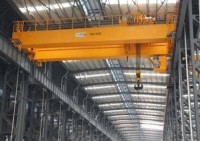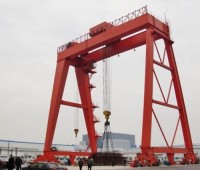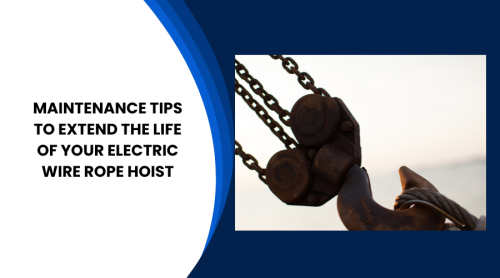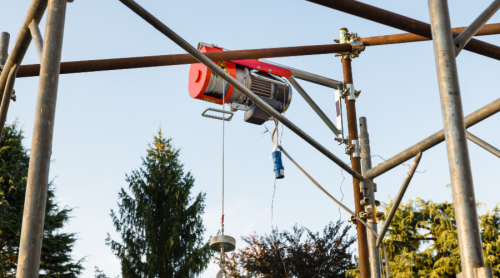Maintaining a wire rope hoist is about more than just checking off to-do list. It’s about understanding how wear happens over time, spotting early signs of problems, and catching issues before they become dangerous. Regular checks help keep the wire ropes in good shape, which means the hoists last longer and the people and things they lift stay safe. This involves inspecting for signs of damage, keeping the ropes well-lubricated, and following rules to avoid overloading or misuse. This guide covers the complete maintenance requirements of wire rope hoists to ensure that they remain in excellent condition for onsite challenging tasks. By having awareness of these tips the maintenance workers and operators can maximize the usage and efficiency of wire hoists and also raise the productivity of their facilities. Understanding Wire Rope Hoist No lifting or loading operation can be run without one crucial piece of machinery: the wire rope hoist. This simple yet effective machine is what saves hours of labor effort by automating moving of loads reliably. The hoist machine is connected to a wire rope which is strong and flexible so it can lift heavy loads without fail. Let us take a deeper look at wire rope hoists and its operating mechanism and how they make lifting work easier for various industries. Basic Operation Configuration Having a basic knowledge of the mechanism of the wire rope hoist is crucial for choosing the tasks that can be handled best by the machine without putting unnecessary stress on it. This means that users can get the most out of their machine by maximizing usage life. We can understand the mechanism better by looking at the basic components of the wire rope hoist. Wire rope: This consists of a woven assembly of steel wires that are robust yet flexible enough to handle the lifting task. Drum: this is the part around which the rope winds or unwinds to alter the length of the wire during the lifting and lowering of the load. Motor (powered hoists): The motor rotates the drum clockwise or anti-clockwise for lifting the load. Gear system: this component outputs hydraulic energy to turn the drum at a regulated speed. Lifting hook: it is the part that securely attaches to the load for reliable lifting. Types of Wire Rope Hoists Wire ropes hoists can be subdivided into two different types Electric Hoists: They feature a motor that is well-suited for automatic heavy lifting of loads. Manual Hoists: consist of variants of hand-operated hoists that are more suitable for lighter loads. Industrial Applications of Wire Rope Hoists Manufacturing Facilities: Wire rope hoists are widely used in assemble line manufacturing for handling materials. Construction: For doing all kinds of lifting work at construction sites. This includes lifting construction materials and debris. Logistics: Loading and unloading cargo is the main task of warehouse wire rope hoists. Wire Rope Maintenance Tips Since a wire rope hoist is so crucial equipment for lifting operations, it needs to be well-maintained to keep downtime to the minimum for peak productivity of the operation. Moreover, a malfunctioning wire rope hoist can cause accidents which can result in financial damage and loss of life so keeping them in good condition is vital to prevent such a situation. Some important tips for wire rope hoist maintenance are Daily Visual Inspection: Wire rope, hooks and other components should be scanned visually for wear and tear. Periodic Detailed Inspections: At periodic intervals a more in-depth inspection should be done. The frequency of the inspection should be decided based on usage patterns and environmental conditions. Document findings: maintain a log of inspections and record issues in an organized manner for future reference and corrective action as well as to keep track of parts replacement. Lubrication of the hoist: For smooth operation the wire rope should be lubricated. Lubrication should also be done of other moving parts. Correct Handling Practice: The wire rope should be correctly wound up on the drum without any kink or twists; otherwise, the wire rope has a tendency to weaken if not rolled properly. Electrical system check: Many issues can develop in the electrical system of the hoist. The unit can overheat, or wires can become broken, etc. During check-up confirm if limit switches, warning indicators and brakes are functional. Brake Inspection: Brakes that stay functional are vital for preventing any accidents during lifting so in the inspection process the brake system should be checked for any inefficiency or brake slippage. Load Testing: Assess the load handling capacity of the electrical hoist by running a load testing schedule at fixed periods. Best Practices During Use Implement Load Management: Don’t exceed the hoist’s weight load limit. The load should be attached securely before the lifting starts. Avoid Side Pulling: A complete and accurate alignment of the hoist and the load is necessary for the rope not to drag across the drum. Dragging of rope across the drum can damage the wire rope. Operational Training: Hoist operators should be adequately trained to handle the hoist well. The user should be aware of load limits, emergency procedures, and hoist controls. Common Mistakes to Avoid Neglecting to Consider Manufacturing Guidelines: Many operators commit the mistake of not considering manufacturers’ guidelines or having insufficient knowledge of them, and this means that accidents can occur due to ignorance of operational specifications. Ignoring Wear and Tear Symptoms: Not taking proactive action regarding wear and tear of components is another mistake that is frequently committed by hoist owners. The wear and tear usually happens in hoist components and wire rope. Overloading: Loading more than the weight limit will put stress on the rope and the electrical hoist mechanism. The stressed parts will reduce useful life. Conclusion Summarily, maintenance is not a checklist you have to make to avoid breakdowns or extend the lifetime of your gear by a couple of years. It forms a very important aspect of operator safety and the integrity of each load. Ignore scheduled maintenance or ask your gear to do more than it’s built for, and you’re not just risking a little downtime—you’re risking major safety incidents that can cost way more than whatever you’re “saving.” A safety-first culture is vital for minimizing accidental risks, and that means strict adherence to manufacturer maintenance guidelines, but that is not the only focus; the focus should be proactive maintenance, as it’s the backbone of safe and efficient operations. FAQs Q: Can I use a hoist to move a load sideways? A: No, hoists are specifically designed for vertical lifting only. Side loading—pulling or dragging a load sideways—can cause serious damage to the hoist and create safety hazards. Q: Is it okay to store a hoist outdoors or in harsh conditions? A: No, hoists should not be left exposed to harsh environments without proper protection. Always store the hoist in a dry, secure place to prevent damage to the wire rope and other components. Q: What is shock loading, and why should it be avoided? A: In shock loading, a load is suddenly loaded or jolted. This has a potential to instantly wear out the wire rope and weaken the mechanical integrity of the hoist. Repository loads should be lifted smoothly and gradually.

The Electric Single Girder Overhead Crane is a versatile and durable lifting solution designed for a wide range of industrial applications. It features a single girder structure, ideal for operations requiring efficient material handling, even in limited spaces. Powered by an electric hoist, this crane can safely lift and move heavy loads across workshops, factories, and warehouses. Key Features: Customizable Design: Tailored to meet specific lifting requirements such as load capacity, span, and lifting height. Efficient Operation: Smooth and reliable electric hoist system ensures precise load handling with minimal manual effort. Durable Construction: Made from high-quality steel, offering high tensile strength, corrosion resistance, and long-term performance. Safety Mechanisms: Equipped with limit switches, emergency stop, and overload protection for safe operation. Compact and Space-Saving: Ideal for environments with restricted headroom or floor space. This crane is ideal for industries like manufacturing, logistics, and construction, offering enhanced productivity and safety.



.png)













